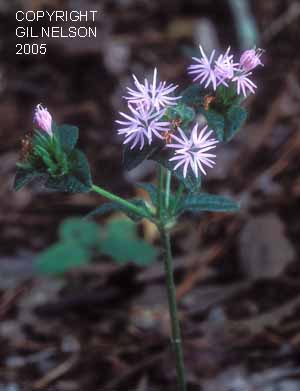Difference between revisions of "Elephantopus tomentosus"
| Line 33: | Line 33: | ||
===Phenology=== <!--Timing off flowering, fruiting, seed dispersal, and environmental triggers. Cite PanFlora website if appropriate: http://www.gilnelson.com/PanFlora/ --> | ===Phenology=== <!--Timing off flowering, fruiting, seed dispersal, and environmental triggers. Cite PanFlora website if appropriate: http://www.gilnelson.com/PanFlora/ --> | ||
| − | It has been observed flowering from April through October.<ref name=fsu/> | + | ''E. tomentosus'' generally flowers from August to November.<ref name= "Weakley"/> It has been observed flowering from April through October.<ref name=fsu/> |
<!--===Seed dispersal===--> | <!--===Seed dispersal===--> | ||
<!--===Seed bank and germination===--> | <!--===Seed bank and germination===--> | ||
Revision as of 14:06, 6 May 2019
| Elephantopus tomentosus | |
|---|---|

| |
| Photo taken by Gil Nelson | |
| Scientific classification | |
| Kingdom: | Plantae |
| Division: | Magnoliophyta - Flowering plants |
| Class: | Magnoliopsida – Dicotyledons |
| Order: | Asterales |
| Family: | Asteraceae ⁄ Compositae |
| Genus: | Elephantopus |
| Species: | E. tomentosus |
| Binomial name | |
| Elephantopus tomentosus L. | |

| |
| Natural range of Elephantopus tomentosus from USDA NRCS Plants Database. | |
Common name: Devil's grandmother; common elephant's-foot
Contents
Taxonomic notes
Description
A description of Elephantopus tomentosus is provided in The Flora of North America.
Distribution
E. tomentosus is native to the southeastern Coastal Plain from Maryland south to the Florida panhandle, west to eastern Texas and Arkansas, and north up to western North Carolina and Kentucky. It is also native south of the United States to Chiapas, Mexico.[1]
Ecology
Habitat
Generally, this species can be found in usually fairly dry woodlands and woodland borders.[1] It has been observed in mixed woodlands, pine-hardwoods, edges of mixed hardwoods, in deciduous woodlands along river bluff, edges of rivers, longleaf pine-Turkey oak woods, open pinelands, and dry upland pine woodlands. Is also found in human disturbed areas such as roadsides and areas that have been clear cut. Requires some light to full light levels. Is associated with areas that have dry, loamy sand and sand soil types.[2]
Associated species include Sericocarpus asteroids, Eupatorium album, E. perfoliatum, E. rotundifolium, Solidago rugosa, Helianthus strumosus.[2]
Phenology
E. tomentosus generally flowers from August to November.[1] It has been observed flowering from April through October.[2]
Fire ecology
It is found in areas that are annualy burned, such as longleaf pine terrain.[2]
Conservation and management
Cultivation and restoration
Photo Gallery
References and notes
- ↑ 1.0 1.1 1.2 Weakley, A. S. (2015). Flora of the Southern and Mid-Atlantic States. Chapel Hill, NC, University of North Carolina Herbarium.
- ↑ 2.0 2.1 2.2 2.3 Florida State University Robert K. Godfrey Herbarium database. URL: http://herbarium.bio.fsu.edu. Last accessed: June 2014. Collectors: Loran C. Anderson, James R. Burkhalter, Robert K. Godfrey, Angus Gholson, Wilson Baker, Paul L. Redfearn, Jr., Richard S. Mitchell, John C. Ogden, Cecil R Slaughter, R. Komarek, R. A. Norris, and J. M. Kane. States and Counties: Florida: Alachua, Calhoun, Escambia, Gadsden, Jackson, Jefferson, Leon, Liberty, Okaloosa, Santa Rosa, Wakulla, and Walton. Georgia: Thomas.